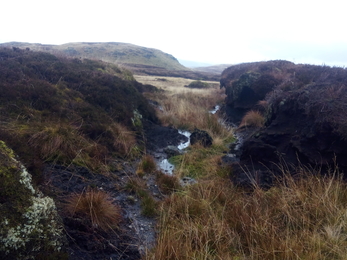Most peat extraction has now ceased in Cumbria but the damage will take many generations to recover
Shap Fells
Shap Fells is an area of fell that lies in the eastern Lake District. It ranges from 300m to 637m above sea level. There are expanses of blanket bog found throughout the area, with over 13km2 having been identified.
Restoration Area: 3.5km2
Owner: United Utilities
Conservation status: Site of Special Scientific Interest (SSSI), Special Area of Conservation (SAC)
Cost of restoration: Phase 1: £100,000. Phase 2: £134,000
The problem: Shap Fells is an area of upland blanket bog that has suffered from historic peat cutting and gripping, leading to extensive erosion. The large number of steep peat faces and areas of gullies means that the peat is slowly oxidising, and in heavy rain it is being washed into the becks below. Although grazing has been completely excluded from the area, the damage shows no signs of healing naturally and degradation will continue without mechanical interventions as a result of high weather exposure. There are also significant areas of bare peat amongst the hags and numerous gullies throughout this area.
What Cumbria Wildlife Trust did: Erosion features, drains, and grips were identified and digitally mapped using aerial photographs. This mapping was then checked in the field to get a detailed map of all the erosion features. From this mapping, restoration plans were developed and tender documents produced.
Using specialist machinery, 70km of hags were re-profiled and revegetated, and 9700m2 of bare peat was revegetated. Over 3700 individual bunds were created in gullies, along the bases of hags and in hollows to hold back water and restore the hydrology of the site.
Benefits: Peatland restoration at this site will help reduce the amount of peat particles reaching Wet Sleddale Reservoir below. This will improve the water quality and reduce the need for expensive pre-treatment of the water. Keeping the peat wet and on the common will also reduce carbon emissions from the site, as well as increasing the biodiversity of the site.
Species benefitting: Plants: Heather, common cottongrass, hare’s-tail cottongrass, deergrass, cross-leaved heath, crowberry, bilberry, cowberry, cranberry, cloudberry, bog rosemary, bog asphodel, sundew, purple moor-grass, soft rush, and sphagnum moss. Animals: Golden plover, short-eared owl, merlin, snipe, and red grouse.
Take a look at our other peatland restoration projects
- Bampton Common Peatland Restoration (https://www.cumbriawildlifetrust.org.uk/bampton-common-peatland-restoration)
- Borrowdale Moss Peatland Restoration (https://www.cumbriawildlifetrust.org.uk/borrowdale-moss-peatland-restoration)
- Armboth Fell Peatland Restoration (https://www.cumbriawildlifetrust.org.uk/armboth-fell-peatland-restoration)
- Tebay Common Peatland Restoration (https://www.cumbriawildlifetrust.org.uk/tebay-common-peatland-restoration)
- Nichols Moss Peatland Restoration (https://www.cumbriawildlifetrust.org.uk/nichols-moss-peatland-restoration-0)

